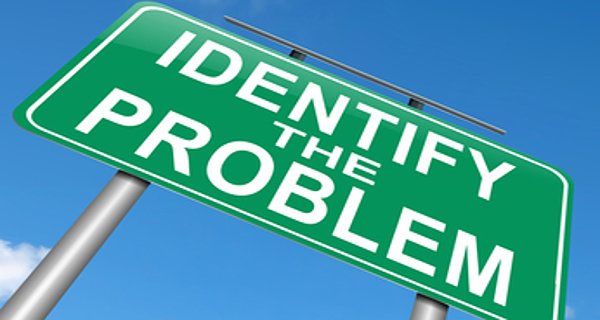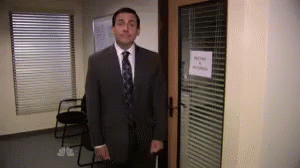Identifying and Not Tolerating Problems.

After you set your goals, you must come up with a plan or a design to achieve them and then you must execute that plan by doing the tasks. On the way to achieving your goals and executing your design, you will encounter problems that have to be diagnosed, so that the design can be modified to get around these obstacles. That’s why you need to identify and not tolerate problems.
Most problems are potential improvements screaming at you.
Whenever a problem surfaces, you have in front of you an opportunity to improve. The more painful the problem, the louder it is screaming. In order to be successful, you have to 1) perceive problems and 2) not tolerate them.
If you don’t identify your problems, you won’t solve them, so you won’t move forward toward achieving your goals. As a result, it is essential to bring problems to the surface.
Most people don’t like to do this. But most successful people know that they have to do this.
The most common reasons people don’t successfully identify their problems are generally rooted either in a lack of will or in a lack of talent or skill:
They can be “harsh realities” that are unpleasant to look at, so people often subconsciously put them “out of sight” so they will be “out of mind.”
Thinking about problems that are difficult to solve can produce anxiety that stands in the way of progress.
People often worry more about appearing to not have problems than about achieving their desired results, and therefore avoid recognising that their own mistakes and/or weaknesses are causing the problems. This aversion to seeing one’s own mistakes and weaknesses typically occurs because they’re viewed as deficiencies you’re stuck with rather than as essential parts of the personal evolution process.
Sometimes people are simply not perceptive enough to see the problems.
Some people are unable to distinguish big problems from small ones. Since nothing is
perfect, it is possible to identify an infinite number of problems everywhere. If you are unable to distinguish the big problems from the little ones, you can’t “successfully” (i.e., in a practical way) identify problems.
Remember, you don’t have to be good at any of the five steps (in this case, identifying problems) to be successful if you get help from others. So push through the pain of facing your problems, knowing you will end up in a much better place.
When identifying problems, it is important to remain centered and logical.
While it can be tempting to react emotionally to problems and seek sympathy or blame others, this accomplishes nothing. Whatever the reasons, you have to get over the impediments to succeed. Remember that the pains you are feeling are “growing pains” that will test your character and reward you if you push through them. Try to look at your problems as a detached observer would. Remember that identifying problems is like finding gems embedded in puzzles; if you solve the puzzles you will get the gems that will make your life much better. Doing this continuously will lead to your rapid evolution. So, if you’re logical, you really should get excited about finding problems because identifying them will bring you closer to your goals.
How good are you at perceiving problems?
How confident are you that your assessment of your ability to perceive problems is right?
If you are confident of your self-assessment, why should you be confident (e.g. because you have a demonstrated track-record, because many believable people have told you, etc)?
Be very precise in specifying your problems.

It is essential to identify your problems with precision, for different problems have different solutions. For example, if your impediments are due largely to issues of will—to your unwillingness to confront what is really happening—you have to strengthen your will, for example by starting small and building up your confidence.
If your problems are related to lack of skill or innate talent, the most powerful antidote is to have others point things out to you and objectively consider whether what they identify is true. Problems due to inadequate skill might then be solved with training, whereas those arising from innate weaknesses might be overcome with assistance or role changes. It doesn’t matter which is the case; it only matters that the true cause is identified and appropriately addressed.
The more precise you are, the easier it will be to come up with accurate diagnoses and successful solutions. For example, rather than saying something like “People don’t like me,” it is better to specify which people don’t like you and under what circumstances.
Don’t confuse problems with causes.
“I can’t get enough sleep” is not a problem; it is a cause of some problem. What exactly is that problem? To avoid confusing the problem with its causes, try to identify the suboptimal outcome, e.g., “I am performing badly in my job because I am tired.”
Once you identify your problems, you must not tolerate them.
Tolerating problems has the same result as not identifying them (i.e., both stand in the way of getting past the problem), but the root causes are different. Tolerating problems might be due to not thinking that they can be solved, or not caring enough about solving them. People who tolerate problems are the worse off because, without the motivation to move on, they cannot succeed. In other words, if you are motivated, you can succeed even if you don’t have the abilities (i.e., talents and skills) because you can get the help from others. But if you’re not motivated to succeed, if you don’t have the will to succeed, the situation is hopeless.
How much do you tolerate problems?
How confident are you that your assessment of how much you tolerate problems is right?
People who are good at this step—identifying and not tolerating problems—tend to have strong abilities to perceive and synthesise a clear and accurate picture, as well as demonstrate a fierce intolerance of badness (regardless of the severity).
Can you comfortably identify your problems without thinking about how to solve them? It is a good exercise to just make a list of them, without possible solutions. Only after you have created a clear picture of your problems should you go to the next step-- diagnosing the problems, which I will discuss in my next blogpost.
Thank You

Trade on Binance. Where the fees are only 0.05%.

You've been upvoted by TeamMalaysia Community :-
To support the growth of TeamMalaysia Follow our upvotes by using steemauto.com and follow trail of @myach
Vote TeamMalaysia witness bitrocker2020 using this link vote for witness